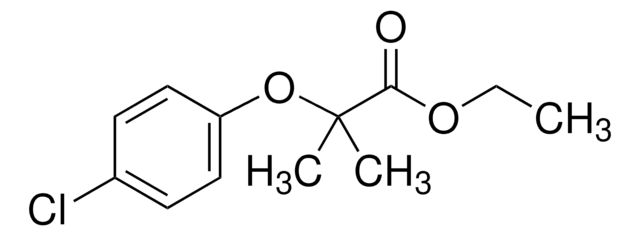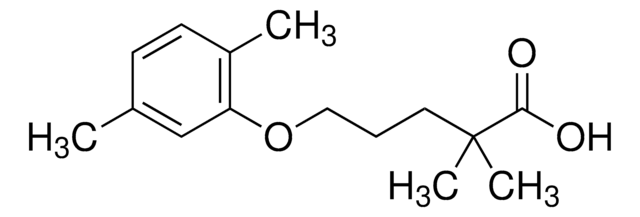C6643
Clofibrate
liquid
Synonym(s):
2-(4-Chlorophenoxy)-2-methylpropionic acid ethyl ester, Ethyl 2-(4-chlorophenoxy)-2-methylpropionate, Ethyl 2-(4-chlorophenoxy)isobutyrate
About This Item
Recommended Products
form
liquid
color
clear colorless
density
1.14 g/mL at 25 °C (lit.)
originator
Wyeth
storage temp.
2-8°C
SMILES string
CCOC(=O)C(C)(C)Oc1ccc(Cl)cc1
InChI
1S/C12H15ClO3/c1-4-15-11(14)12(2,3)16-10-7-5-9(13)6-8-10/h5-8H,4H2,1-3H3
InChI key
KNHUKKLJHYUCFP-UHFFFAOYSA-N
Gene Information
human ... PPARA(5465)
mouse ... Ppara(19013)
Looking for similar products? Visit Product Comparison Guide
Application
- as a quinolinate phosphoribosyltransferase (QPRT) agonist to study its effects on hepatitis C virus (HCV) infection
- as peroxisome proliferated activated receptor (PPAR) agonist to study its effects on autophagy in rat liver cells
- as a hepatotoxicant to study its effects on gene expression in primary rat hepatocytes
Biochem/physiol Actions
Features and Benefits
Packaging
Signal Word
Danger
Hazard Statements
Precautionary Statements
Hazard Classifications
Acute Tox. 4 Oral - Eye Dam. 1 - Skin Irrit. 2 - STOT SE 3
Target Organs
Respiratory system
Storage Class Code
10 - Combustible liquids
WGK
WGK 3
Flash Point(F)
235.4 °F - closed cup
Flash Point(C)
113 °C - closed cup
Personal Protective Equipment
Certificates of Analysis (COA)
Search for Certificates of Analysis (COA) by entering the products Lot/Batch Number. Lot and Batch Numbers can be found on a product’s label following the words ‘Lot’ or ‘Batch’.
Already Own This Product?
Find documentation for the products that you have recently purchased in the Document Library.
Customers Also Viewed
Articles
Cholesterol synthesis regulation by dietary levels, LDL receptors control lipid-rich LDL particle transport in cells.
Cholesterol synthesis regulation by dietary levels, LDL receptors control lipid-rich LDL particle transport in cells.
Cholesterol synthesis regulation by dietary levels, LDL receptors control lipid-rich LDL particle transport in cells.
Cholesterol synthesis regulation by dietary levels, LDL receptors control lipid-rich LDL particle transport in cells.
Our team of scientists has experience in all areas of research including Life Science, Material Science, Chemical Synthesis, Chromatography, Analytical and many others.
Contact Technical Service
















